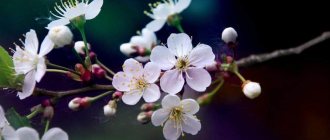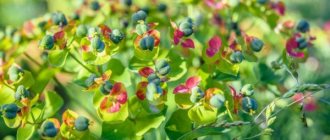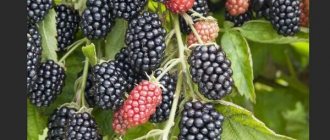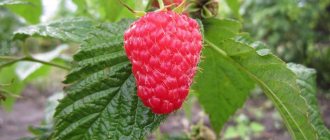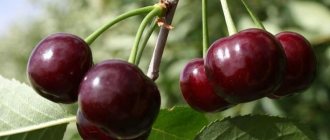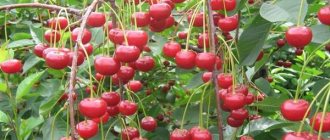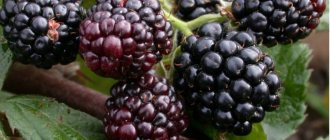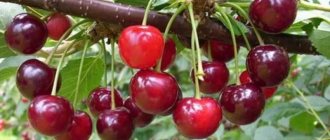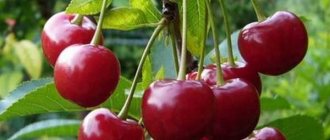- Features and characteristics of the Vladimir Cherry variety: planting, care, pollinators, protection from pests and diseases
- Description and features of Vladimir cherry
- Characteristics of the variety “Vladimir cherry”
- Advantages and disadvantages of Vladimir cherry
- Secrets of growing Vladimir cherries
- Choosing a place to plant cherries
- Preparing the site for planting cherries
- Selection of cherry seedlings
- Planting cherry seedlings: step-by-step process
- Caring for Vladimir cherry
- Cherry pruning
- Video: how to trim cherries
- Watering and fertilizing cherries
- Autumn and spring work on caring for cherries
- Video: protecting a young tree from rodents in winter
- Cherry diseases and pests
- Cherry harvest
- Reviews from gardeners about Vladimir cherry
- Video: Vladimir cherry
Description and features of Vladimir cherry
A very old variety of folk selection, widespread in Russia. Its origin is lost far in the centuries of history, and it is hardly possible to restore it with great accuracy.
There is a version that in the 16th century. It was brought with them by wandering monks from the southern countries, and it acclimatized and spread to the lands of Vladimir and the adjacent provinces.
The optimal combination of acids and sugars, density and juiciness of the pulp, and delicate aroma still make this variety in demand among Russian gardeners.
Over many centuries, it was propagated not only by offspring, but also by seeds - hence the wide variety of forms, and currently Vladimir cherry is a collective concept of existing clones and seedlings with all their positive and negative signs and properties. Vladimir cherry is included in the State Register for the North-Western, Central, Volga-Vyatka, Central Black Earth and Middle Volga regions; zoned since 1947
Harvesting and processing
Harvesting
The harvest does not ripen all at once, but gradually, in waves, depending on the size of the berry and the place where it is located. Thus, the side of the cherry facing the sun almost throughout the day ripens faster. The harvest falls from July 10 to July 25.
It has been proven that the taste of the described cherry variety directly depends on the growing region. The more sunlight the berries receive during the ripening period, the sweeter they will be. Care, feeding, and spraying also have a great influence. At the same time, gardeners are unanimous in the opinion that Vladimir cherry is ideal for home and industrial processing. Compotes, preserves, jams are prepared from it, and they are also dried and frozen.
Characteristics of the variety “Vladimir cherry”
This is a typical bush cherry. Self-rooted plants form multi-stemmed bushes 2.5-5.0 m or more in height. When grafted, it forms single-standard trees. The trunk and skeletal branches are ash-gray in color, the bark is flaky, with longitudinal cracks.
If each cherry variety had its own pedigree, then the Vladimirskaya variety would have no competitors in terms of the antiquity of the genus.
The crown is round, spreading with age, weeping, slightly leafy inside; skeletal branches are ascending, extending from the trunk at an angle of 50-60°.
Annual branches are yellowish brown, with a silvery coating closer to the base, drooping.
Vegetative buds are conical, small, deviating from the shoot, generative buds are oval.
Vladimir cherry is in demand in both amateur and industrial gardening.
A characteristic feature of the leaves is that they are folded in a “boat” along the main vein.
They are of medium size - 83 x 39 mm, matte, elongated oval or elongated ovoid with a gradually tapering apex and a slightly pointed base; the edges of the leaf blade are serrated; petiole 12 mm, medium thickness, with significant anthocyanin pigmentation; glands of 1-3, located on the petiole at the base of the leaf blade, less often at its base, small, dark red.
Flowers up to 5-7 in one inflorescence, average size - 28 mm, saucer-shaped, with a broadly oval and slightly forked apex, touching petals; the stigma of the pistil is at the level of the anthers, the length of the style is 8 mm, the length of the stamen filaments is 5-6 mm; the calyx is goblet-shaped, with anthocyanin coloring on the sunny side; pedicel 18-23 mm, with anthocyanin coating.
It is important that during the cherry blossom there are no frosts, which significantly reduce its yield.
It bears fruit like bush cherries - more than 80% of the fruits are located on annual branches.
Fruits are small (12.1 x 13.7 x 12.5 mm) to medium (16 x 20 x 17.5 mm) in size, weighing from 2.5 to 3.4 g, flat-round, slightly compressed on the ventral suture side , with a rounded top and a shallow, tight funnel; the abdominal suture is barely noticeable. The skin is black-red, covered with numerous gray dots, the flesh is dark red, dense, fibrous, juicy, very good sour-sweet, harmonious taste; The juice is thick, dark cherry.
Under northern cultivation conditions (St. Petersburg), the pulp contains: solids - 16.4%, sugars -10.9%, free acids -1.7%, ascorbic acid - 26.6 mg per 100 g of wet weight; in the conditions of the Krasnodar Territory (Maikop): dry matter - 18.5%, sugars - 11.46%, free acids -0.67%, ascorbic acid - 4.6 mg/100g.
The stone is easily separated, weighing 0.3 g, 8.3% of the total weight of the fruit, brown, 10 x 8 x 7 mm, broadly oval to ovoid. The stalk is 29-45 mm, thin, and when the fruit is fully ripe, it comes off very easily, with a dry tear off. Grafted plants begin to bear fruit 2-3 years after planting.
Vladimir cherry fruits are good for both fresh consumption and canning.
In terms of flowering and fruiting times, it belongs to the medium group; 60 days pass from the beginning of flowering to the beginning of ripening. In central Russia, the fruits ripen in mid-July. The fruits do not ripen at the same time; a delay in harvesting can lead to their shedding.
The variety is self-sterile. The best pollinators are:
- Amorelle pink;
- Vasilievskaya;
- Griot Moscow;
- Lotovaya, Lyubskaya;
- Fertile Michurina;
- Rastunya;
- Turgenevka;
- Black consumer goods.
winter hardiness is good, but generative buds can be significantly damaged by low winter temperatures, which often causes low yields and prevents the variety from spreading to the northern regions of central Russia. Observations indicate that freezing of generative buds over 10 years in the conditions of the Leningrad region averaged 1.1 points (by year from 1 to 3 points). Productivity varies greatly depending on the cultivation area and overwintering weather conditions, and is generally moderate to good. In central Russia, in favorable years (during the period of full fruiting of plants), the harvest can be up to 20-25 kg of fruit per tree; in the northern latitudes (Leningrad region) at the age of 10 years it yields only up to 5 kg.
The fruits of Vladimir cherries are characterized by excellent taste, have a universal purpose, and are suitable for the production of high-quality processed products: jam, compotes, dried fruits and quick freezing. The variety is used for wide production plantings in central Russia and amateur gardening.
It is necessary to select high-yielding clones with the best biological and economic indicators.
Currently, Vladimir cherry is grown throughout almost the entire territory of Russia, Ukraine, Belarus and countries with similar climatic conditions. In some cases it is referred to under other names:
- Izbyletskaya;
- Vyaznikovskaya;
- Dobroselskaya;
- Gorbatovskaya;
- Parenteleva.
For more northern latitudes and the southern fruit growing zone it is of limited interest.
Description of the variety
It is necessary to immediately make a reservation that it is easy to get confused in the varieties of the Vladimirskaya variety. This is due to the fact that over its centuries-old history, cherries have been propagated both by shoots and by seeds.
The first description of cherry varieties from the Vladimir land (Vasilievskaya, Parental, Kulagikha, Kislikha) was given in 1801 in the “Geographical Dictionary of the Russian State”.
Until now, along with Vladimirskaya, you can find the names of the varieties Roditeleva, Vyaznikovskaya, Dobroselskaya, Gorbatovskaya, Izbyletskaya. In fact, Vladimir cherry is a generalized concept of existing clones and seedlings, registered in the State Plant Register in 1947. Thus, a kind of standard was set for Vladimirka.
Vladimirskaya is zoned for the Central, Northwestern, Upper Volga, Central Chernozem and Middle Volga regions. The main advantage of cherries is their excellent taste. At the same time, this ancient variety turned out to be defenseless against a set of modern fungal diseases.
Characteristic features of Vladimir cherry - table
| Characteristic | Description |
| Plant type | Bush, multi-trunk. When grafted, it forms single-standard trees. |
| Lifespan | 15–20 years. |
| Crown | Round, sparsely leafy, dense. The skeletal branches are located at approximately 60 degrees to the horizontal. |
| Cherry height | 2.5–5 m. |
| Leaves | Serrated, dark green, 80x40 mm in size, folded in the shape of a boat along the central vein. |
| Trunks, branches | Trunks with longitudinal cracks, ash color. Annual branches are yellow-brown with a silvery coating. |
| Inflorescences | 5–7 white flowers in an inflorescence, about 28 mm in diameter, petals touching. |
| Fruit | Small and medium-sized, 12–18 mm in diameter, weighing 2.5–3.5 g. Dark color with numerous gray spots, burgundy flesh, dense, juicy. The taste is sweet and sour, slightly tart, excellent. The bone separates well. |
| peduncle | Size - 30–43 mm. It comes off easily, the tear off is dry. |
| Fruiting period after planting | For 2–3 years. |
| Fruit ripening period | Average, 2 months after the start of flowering, non-simultaneous. |
| Pollinators | Pink Amorelle, Moscow Griot, Lotovaya, Lyubskaya, Fertile Michurina, Rastunya, Turgenevka, Pink Flask. |
| Winter hardiness | Wood - good, flower buds - average. |
| Resistance to fungal diseases | Low. |
Vladimir cherry at the time of flowering and fruiting - photo gallery
Bush Vladimirskaya blooms very beautifully
Cherry inflorescences contain 5–7 white flowers
The cherry blossoms seem to have fallen from heaven - so good! (Kobayashi Issa)
Cherries ripen at different times
Ripe dark cherry with gray spots under the skin
Vladimir cherry bush tree - video
Advantages and disadvantages of Vladimir cherry
Gardeners who grow Vladimir cherries in areas with a temperate climate note its advantages when characterizing this variety. One of its main advantages is considered to be high-quality fruits of universal use and high yield. With proper care, you can harvest 25 kg of ripe cherries from a mature tree. The tree is unpretentious, quickly acclimatizes and gets used to growing in a new area. Good frost resistance allows you not to worry about insulating the tree for the winter. The fruits are early-bearing and have good taste. In this case, the seed is easily separated from the fruit.
As a sign of love for this fruit tree, a monument was erected in the historical part of Vladimir.
Despite the advantages of cherries, a description of the variety would be incomplete without listing the disadvantages. This:
- reduced frost resistance of generative buds;
- susceptibility to fungal diseases - coccomycosis and moniliosis.
Productivity directly depends on climatic conditions. In addition, the variety is self-sterile. Another disadvantage is that untimely harvesting leads to shedding of ripened fruits.
Characteristics
Vladimir cherry is grown by farms and amateur gardeners. The variety is widespread and is recognized by residents of most regions of Russia, despite the abundance of new cultivars with excellent characteristics.
Resistance to adverse factors
Vladimir cherry wood has good frost resistance, but the buds often freeze, and the yield strongly depends on winter temperatures. According to gardeners, growing the variety in the south is problematic - it has low drought resistance.
Taste qualities
Vladimirskaya is a universal variety. It is pleasant enough to eat fresh and can be processed. Experts and summer residents characterize the taste of the Vladimirskaya variety as excellent or very good - sweet, with pronounced sourness, barely noticeable tart notes.
The sugar content largely depends on:
- soil,
- average annual temperature,
- amount of precipitation,
- number of sunny days during the growing season.
Pollinators
Vladimirskaya is a self-sterile variety. In the absence of pollinators within a radius of 40 m, the tree will give up approximately 5% of the possible number of berries. To get a decent harvest, the following varieties are planted nearby:
- Vasilievskaya;
- Lotovaya;
- Lyubskaya;
- Rastunya;
- Turgenevka;
- Pink Amorelle;
- Moscow Griot.
Advice! If the garden is small, you can graft a branch of Lyubskaya onto the Vladimirskaya tree. This technical variety is universal - it provides pollination of almost all cherries.
Fruiting
Vladimirskaya is a medium-fruiting variety. The harvest is harvested 3-4 seasons after planting own-rooted trees, and from grafted trees - a year earlier.
The ripening period of Vladimirskaya is average. It takes approximately 60 days from flowering to fruiting. The cherries are poured unevenly and require several pickings.
Important! The ripe fruits of Vladimirskaya will quickly fall off if you do not pick them off in time.
The absence of fruit on a healthy tree after a particularly cold winter is due to the mediocre frost resistance of the generative (flower) buds of the cherry. Therefore, the harvest is unstable.
After a mild winter, an adult Vladimirskaya tree in a moderately warm climate produces up to 25 kg of berries. Near St. Petersburg, 5 kg per season are harvested from 10-year-old cherries.
Advantages and disadvantages
Vladimir cherry has a number of positive and negative qualities presented in the table.
| pros | Minuses |
|
|
Secrets of growing Vladimir cherries
To get a good harvest, you must comply with planting and care requirements. Planting Vladimirovskaya cherries is essentially the same as in the case of other varieties. There are no special differences in this case. The best time to plant cherries in areas with frosty winters is in the spring. Poorly rooted seedlings planted in autumn may freeze in winter. In the central regions of the country, trees are planted in April, and in the south, planting is carried out in September, so that the strong summer heat does not affect the seedlings. To do this, seedlings purchased in the fall are buried or stored in the basement, sprinkling the roots with wet sawdust.
Basics of agricultural technology
Vladimir cherry does not have any special requirements for planting and care. The location is chosen on a gentle slope, hillock or embankment terrace, well lit, with groundwater lying no closer than 2 meters to the surface. Cherry trees should be protected from strong winds in winter by buildings, fences or large trees.
It is necessary to plant cherries in the Moscow region, the central zone and regions with a cool climate only in the spring, before the buds open. The hole for the tree is prepared in the fall.
An ideal soil has the following characteristics:
- loose,
- permeable sandy loam or loam,
- with a neutral reaction,
- with a lot of organic matter.
If necessary, add lime or dolomite flour to acidic soil.
Important! When planting, the root neck of the cherry should rise 5-8 cm above the ground.
Before planting, the roots of the seedling should be soaked for several hours in a growth stimulator.
The first time after planting, the tree is watered abundantly. Then the watering is reduced to several times per season, each time spending at least 10 liters of water per linear meter of cherry height. In hot, dry summers and during autumn moisture recharging, the dose of water is doubled.
The soil is loosened only the first year after planting, then the tree trunk is mulched with dry mullein, and shade-tolerant ground covers can be planted there. Cherries love nitrogen and potassium, but need little phosphorus. The ideal feeding is to add mullein and ash to the tree trunk in the fall.
Regular pruning and shaping helps protect the tree from a wide variety of pests. The crown, thanks to the removal of dry, diseased and broken branches, is ventilated, which minimizes harm from coccomycosis and moniliosis, to which the tree is very sensitive, especially in dense plantings. Pruning weak shoots and shortening strong ones contributes to the formation of more bouquet (fruit) branches on the tree.
Cherries are not covered for the winter. Protect from hares, mice, and other rodents by installing a special net around a multi-stemmed tree, or by wrapping the trunk with spruce branches or burlap.
Choosing a place to plant cherries
The tree needs to be planted in an area that is well ventilated, since stagnation of cold air interferes with the normal development of “Vladimirovka”. The variety does not tolerate swampy and acidic soil. It is not advisable to plant seedlings on sandy soils, in lowlands or in areas with high groundwater levels. The distance from one tree to another must be at least 4 m. The proximity of this variety of cherry to a pear, apple tree and black currant is unacceptable.
Before planting, the roots of the seedling are soaked for 6-10 hours in a solution with the addition of stimulants.
The planting area should be well ventilated; cherries cannot tolerate stagnant cold air. She does not like swampy, cold and acidic soils, lowlands, and high groundwater levels . Cherries also grow poorly on sandy soils. It suffers from a lack of moisture, but even with watering and the application of mineral fertilizers it grows well, but bears almost no fruit; the wood is poorly prepared for winter and freezes. The distance between trees should be at least 3–4 meters. It is advisable to plant cherries separately from other trees.
Note! Cherry does not tolerate the proximity of black currant, pear, and apple trees. It is better not to plant anything in the circles of cherry trees except peas and garlic. The first enriches the soil with nitrogen, so the roots and stems do not need to be removed, but rather dug up along with the soil in the tree trunk circle. Garlic protects cherries from aphids with its phytoncides.
Best pollinators
We recommend reading our other articles
- Winter-hardy varieties of peaches
- The best rabbit breeds
- Soybean varieties
- Breed of geese Legart
Vladimir cherry produces a good harvest only if there is a pollinator nearby, since in itself it is self-sterile. But not all types of cherries are suitable as a pollinator for Vladimirskaya. The best pollinators in this case are the following varieties: Rastunya, Lyubskaya, Vasilyevskaya, Amorel pink, Turnegevka, Fertile Michurina, Shirpotreb black, Morel black, Zhukovskaya.
These cherries are planted in close proximity to Vladimirovskaya, but so that the trees do not interfere with each other’s growth. If there are one or more pollinators on the site, gardeners can receive an annual and very high-quality harvest of berries.
Preparing the site for planting cherries
Before planting cherries, the area must be dug up and cleared of harmful insect larvae and weed roots. When planting in spring, this is done in the fall. Mark and dig holes for seedlings. The distance between trees should be at least 4–5 meters. The size of the hole depends on the soil. The more fertile the soil, the smaller the hole and vice versa.
The more fertile the soil, the smaller the diameter and depth of the planting hole for a cherry seedling.
In the middle zone, on heavy loamy soils, holes are made 1 m in diameter and 70–80 cm deep. Fertile soil can be collected in buckets, and the lower layers can simply be scattered around the site; there is no need to add this soil to the planting hole. The pit is filled with fertile soil mixture. It is prepared like this:
- Organic matter is placed at the bottom of the pit. This can be chopped grass, hay, fallen leaves, turf turned upside down, removed when digging a hole, etc.
- Compact.
- Pour out 2-3 buckets of humus or well-rotted compost.
- Add 500–600 g of hardwood ash.
- Fill the buckets with fertile soil from the top layer.
- Pour in 200–300 g of bone meal.
- 200–300 g of dolomite flour to deoxidize the soil.
- Stir lightly without touching the layer of organic matter at the bottom of the pit.
- Water well to allow the soil to settle.
- Mulch with a thick layer of peat, rotted sawdust, pine nut husks, etc.
Planting: step-by-step instructions
The time of spring planting depends on the region. In the Moscow region, it is carried out in the spring, as soon as the snow has melted. To do this, choose a dry, windless and warm day. The holes are prepared in advance - a month before planting, holes measuring 60 cm3 are dug at a distance of 3 m from each other. An interval of 3.5 m is maintained between the rows. A peg is driven into the center of each recess - it will support the young plant. Planting holes are fertilized if this was not done during digging. To do this enter:
- ash - 0.5 kg;
- phosphorus fertilizer - 300 g;
- potassium fertilizer - 80 g;
- manure - 15 kg.
Prepared seedlings (inspected and selected) are planted:
- Earth is poured near the peg, forming a hill of 50 cm.
- The roots of the seedling are spread over the entire surface, sprinkled with earth on top, carefully but firmly compacting it.
- Form a small hole near the tree.
- Water well (for one seedling - 3 buckets of water, which should be at room temperature).
- The watered soil is lightly sprinkled with earth, and the tree is tied to a support.
After planting, the cherry tree must be tied to a peg installed in the planting hole
Video: how to plant cherries
Selection of cherry seedlings
When purchasing seedlings, it is better to give preference to annual specimens that have better survival rate. Seedlings for planting can be purchased at a nursery or garden center. Or you can grow it yourself from a seed or root shoot of an existing tree of this variety. It should only be taken into account that such seedlings begin to bear fruit 2–3 years later than the grafted ones. And plants grown from seed may not reproduce the varietal characteristics of Vladimir cherry.
Cherry seedlings in nurseries will be dug up immediately at the time of sale.
The best results are obtained by propagating cherries using green cuttings. Plants grown in this way have an intact root system and take root better. And seedlings obtained from the root offspring of such cherries completely repeat the varietal characteristics of the mother tree.
As already mentioned, you need to purchase seedlings from the nearest nurseries, making sure that they are grown here and that the seedlings are guaranteed to correspond to the declared variety. If a tree is dug up before the dormant period, you need to pay attention to its leaves. They should not show signs of disease. The bark is without cracks, stains and signs of gum formation.
When purchasing seedlings, give preference to annual seedlings, they have better survival rate.
Note! If grayish or brown oval or comma-shaped tubercles are present on the branches of a seedling, this plant is infected with scale insects or false scale insects. Such pests can destroy not only individual trees, but also huge gardens. Under no circumstances should you buy such a seedling.
Signs of scale insect infestation.
The root system should be branched and fibrous. The roots themselves are no shorter than 30–35 cm, live, and light in color when cut. There should be no swelling or damage on them.
Methods of combating scale insects and false scale insects: (read more)
Biological features and characteristics
The Vladimirskaya cherry variety has its own characteristic features.
Description of the tree
In its natural form, this cherry is a multi-stemmed bush-like fruit tree that grows up to 5 m. The grafted cherry looks like a standard tree with a rounded crown. Over time, it droops and has a weeping appearance. The bushes that emerge from the shoots can be 2–3 m high. The lifespan of the tree is approximately 27 years. Early fruiting is good - fruits can be collected 2-3 years after planting.
The bark is dark gray and has cracks along the trunk and branches. In older specimens, the bark peels off. On young branches the bark is lighter, yellowish or brick-colored. The main part of the fruits is formed on annual trees. The peculiarity of the variety is the weak foliage of the tree. The length of the leaflets is 8–9 mm, and the width is almost 2 times less. The oval, elongated leaves are jagged along the edge and are attached to the branches with red-brown stalks. In spring, the tree forms small inflorescences with 5–7 flowers. Their corolla, 25–30 mm in size, has a red-brown calyx and white petals.
Description of fruits
Cherries have a sweet and sour taste. They have small or medium parameters, depending on climate and weather. The weight of the fruit is usually no more than 3.5 g. Cherries remain on the branches for quite a long time and can fall off on their own. They have a slightly compressed shape with a small funnel and a weakly defined ventral suture. An easily detachable stalk 4.5 cm long is attached to the ripe fruit. Ripe cherries are painted in a rich dark burgundy color with specks of grayish color.
The pulp is red-burgundy in color and has a fairly dense structure with pronounced fibers. The roundish seed weighing about 8.5% of the total fruit weight is easily separated from the juicy pulp. In northern regions the berries are more sour due to lack of sunlight, while in warmer climates they are sweeter.
Pollinators
This is a self-fertile variety and requires pollinating trees. The following varieties bloom at the same time:
- Amorelle pink;
- Turgenevka;
- Morel black;
- Vasilievskaya;
- Griot Michurina;
- Moscow;
- Zhukovskaya;
- Lyubskaya.
Maturation period
The cherry harvest begins to ripen in the middle period. The fruits do not ripen at the same time, and fruiting is extended. Harvesting is carried out from the 1st decade of July until the end of the month. The time from the appearance of color to the formation of fruits takes approximately 2 months.
Did you know? Cherry fruits and leaves are natural antibiotics. They contain natural phytoncides that suppress pathogenic microflora, so cherry leaves are added to preserves - they will prevent rotting processes from occurring.
Planting cherry seedlings: step-by-step process
In the spring, as soon as the ground warms up, before the buds open, they begin planting seedlings. In order for the seedling to take root well, you need to adhere to the following procedure when planting:
- Before planting, the roots of the plants are inspected and damage is cut off.
- Place in water with the addition of Kornevin or other drugs that stimulate root formation for 6–12 hours.
- A stake 80-1.5 m high is driven into the center of the planting hole.
- Make a hole for the roots so that the root neck of the tree protrudes 5–7 cm above the soil level.
- Place the seedling north of the peg, vertically.
- Straighten the roots so that their ends do not bend upward.
- Sprinkle with the removed soil, shaking the seedling slightly to fill the voids under the roots.
- A hole is formed around the perimeter so that water does not affect the root collar.
- Pour 2-3 buckets of water under the tree in several stages.
- Using soft twine, tie the seedling to the peg with a figure eight knot so that the bark is not injured by the stake, and the plant does not stagger under the pressure of the wind and damage the roots.
- Mulch the tree trunk circle with peat, humus, rotted sawdust, husks, etc., 7–10 cm thick.
Note! Mulch protects the roots of the tree from drying out in the summer and from freezing in the winter.
Landing rules
Breeders recommend planting Vladimir cherry seedlings in the spring, when the soil warms up sufficiently. Only in the southern regions, in their opinion, is autumn planting possible.
Attention!
Experienced gardeners, taking into account climate change and the unpredictability of weather conditions, advise planting young trees in early autumn in the middle zone. They will have time to take root before the cold weather sets in.
To grow Vladimir cherries, choose well-lit places protected from the wind. It is better to plant trees on the southern slopes of hills, or on the south side of buildings and hedges. In the latter case, it is worth considering that the crown of an adult Vladimirovka cherry is quite voluminous.
From the soil, select areas with sandy or loamy soil composition, neutral acidity and a high content of organic matter. It is important that moisture does not accumulate at the roots, and groundwater does not come close to the surface.
To plant Vladimir cherry seedlings:
- prepare a hole with a depth of 0.6-1.0 m and a diameter of 1.0-1.2 m;
- the soil is mixed with compost and potassium-phosphorus fertilizers;
- if necessary, add sand to loosen the soil and wood ash to reduce acidity;
- fill the hole with a drainage and fertile layer, forming a small mound;
- install a peg for tying the tree;
- a Vladimirovskaya cherry seedling is placed on a mound, the roots are straightened and the hole is filled in so that the root collar is at a height of 4-6 cm above the soil level;
- water and mulch the root circle with sawdust.
Caring for Vladimir cherry
The tree requires especially careful care for the first 4–5 years, while the root system grows and the crown reaches the size characteristic of the variety. At this time, you need to especially carefully monitor the condition of the tree trunk circle. It should not be sodded and weeds should not be allowed to grow. Shallow loosening and mulching are required. The root collar should be open.
Note! In an adult cherry tree, the trunk circle can be sown with white clover. It does not grow higher than 15 cm, and the roots enrich the soil with nitrogen.
History of the variety
This variety of cherry has a long history. According to legend, it was brought to the Vladimir province by wandering monks in the 22nd century. At first, the seedlings were not winter-hardy, so the monks had to make considerable efforts to grow heat-loving trees. Acclimatized plants began to be planted in other areas. In the 19th century, the city of Vladimir took first place in the number of cherry orchards - there were more than 400 of them. And today, the Vladimir cherry is one of the symbols of this region, it is not for nothing that a monument was erected there in 2014. Over the years, the variety has been propagated and received a wide variety of forms: Vyaznikovskaya, Dobroselskaya, Izbyletskaya, Roditeleva. Since 1947, the variety has been zoned in the North-Western, Central, Volga-Vyatka, Central Black Earth and Middle Volga regions.
A monument to Cherry of Vladimir was erected in Vladimir
Cherry pruning
Cherries are pruned in early spring, 3–4 weeks before buds open. You cannot shorten the skeletal branches, but only carefully remove the excess ones, cutting them into a ring near the trunk itself. There is no need to leave stumps. The sections are disinfected and covered with garden varnish. It can be treated with regular green paint. The crown should consist of 5–7 branches, evenly distributed along the central conductor. The standard is left 30–40 cm, the branches located below are cut out. The central conductor should be 15–20 cm higher than all other branches.
Pruning prevents the crown from thickening, thereby saving you from many problems.
In the future, make sure that growing branches do not thicken the crown. With good growth of at least 40–50 cm, the branches are shortened, moving to a side branch. Remove crowns growing inward, damaged, drying out, and shading other branches. Weak and poorly growing trees are not pruned. An adult standard tree should form about 10 skeletal branches.
The root shoots are removed, not allowing them to grow much, along with the root from which the shoot originated. Superficial removal of growth will bring the opposite result.
Note! To trim cherries, you should not use pruning shears, which, when cutting, compress and injure the branches. It is best to prune with a sharp garden knife. Immediately clean the cuts, disinfect them and coat them with garden varnish.
Bush cherries only need thinning pruning. Remove branches that grow inside the crown, rub against each other, shade others, dry out and are damaged. The shoots of bush cherries are not shortened. Normally, an adult tree of this shape has 15 skeletal branches.
Nuances of care
During active growth, the following activities will be required:
- Watering - 3-4 buckets per adult plant. If the summer is rainy, only fertilizing is needed.
- Application of phosphorus-potassium fertilizers based on fruit crops.
- In autumn - moisture-recharging irrigation.
- Soil deoxidation. It is an important point in tree care. Even on slightly acidic soils, cherries will grow poorly, and harvests may not be expected at all. Before planting in acidic soil, it is necessary to add lime. Substances that normalize acidity: potassium and calcium are added in a timely manner.
The variety is characterized by average winter hardiness, so shelter for the winter will not be superfluous. The tree trunk circle is covered with peat, sawdust, and rotted (but not fresh) leaves.
Recent Entries
5 working ways to use tar in the garden 7 indoor plants that help you get married even in adulthood Indoor plants that can bloom in trouble
To protect against rodents, the lower part of the trunk and branches is wrapped in burlap or any thick paper (newspaper can be used, but packing or wrapping paper is better). Fabric covers are placed on top. This is not very reliable protection against rodents, so you can consider materials such as: plastic bottles, birch bark, roofing felt, iron mesh, nylon tights, spruce branches.
Pruning and shaping the plant
Basic Rules:
- Pruning cherry trees is a controversial issue. If you don’t have confidence in your skills, it’s better not to do it at all.
- In spring, the procedure is not carried out after the buds have swollen, since the risk of fungal infection increases.
- Be sure to remove branches growing inside the crown, dry ones, and damaged by disease.
- Pruning is done in spring and autumn. In the spring - for the purpose of formation, in the fall - as a disease prevention. Summer pruning is carried out only on well-developed trees. In winter, the procedure is unacceptable.
Video: cherry pruning
Watering and fertilizing cherries
Vladimir cherry trees should not be watered too often, because a large amount of moisture helps compact the soil, making it more difficult for air to penetrate to the roots.
Cherries are watered only a few times per season, but abundantly, 10–15 liters of water per tree:
- after flowering;
- during fruit filling 4–5 weeks after the first watering;
- after harvest;
- moisture-recharging irrigation before the onset of cold weather.
Water is poured into furrows 8–10 cm deep, dug around the perimeter of the crown. Do not pour water into a hole that fills the root collar. Water should only fall on the suction roots.
Note! The first year after planting, cherries do not need fertilizer. They begin to feed the tree at 2–3 years of age, after it begins to bear fruit.
Cherries need nitrogen and potassium fertilizers. In the spring, after the snow melts, a complex fertilizer will be required. The amount of nitrogen-containing substances must be adjusted at the rate of 20 g per 1 m².
After the buds swell, a second feeding is carried out: potassium and ammonium nitrate (1 tablespoon each) are added to the tree trunk circle, and then mulching is carried out using compost or humus. Another feeding is carried out at the end of summer or early autumn: after harvesting, the tree must be fed with potassium and phosphate fertilizers. For this, superphosphate (160 g) and potassium sulfate (70 g) are used, which are added while digging the trunk circle. A year later, in the fall, compost or humus is used to fertilize the cherries (1 - 1.5 buckets per tree).
All fertilizing is applied after watering into furrows dug along the perimeter of the crown. You can do without chemical fertilizers, using only organic matter, stove ash and bone meal.
Table, fertilization for cherries:
| Period | Feeding composition (per 1 tree) |
| After the snow melts | Deciduous tree ash - 200–300 g for digging around the tree trunk |
| Before flowering begins (choose one of those suggested) |
|
| During the period of filling and ripening of berries | |
| After harvest |
|
| Under the autumn digging |
Subsequent care of the crop
Subsequent care for cherries of this variety is simple and consists of simple steps:
- Pruning;
- Watering;
- Feeding;
- Disease prevention;
- Pest control;
- Preparing cherries for winter.
It is better to do pruning and crown formation in the spring. But Vladimir cherry does not need too frequent watering. 5-9 buckets of water are used per season, the amount depends on the age of the tree.
For autumn feeding, organic substances (manure, compost, sawdust) are used. In spring, you can use ash and phosphorus fertilizers.
In winter, it is better to wrap the trunk and lower branches of the tree with dense material to protect it from frost and possible attacks by rodents.
Diseases and pests, measures to combat them
Vladimirskaya cherry, unfortunately, is prone to fungal diseases. But timely intervention will not allow this factor to affect the harvest.
| Disease | Symptoms | Control measures |
| Moniliosis | Burn spots appear on leaves and branches. The affected parts are covered with gray growths. The growth of growths, leading to the death of foliage, branches, and berries. | Treating the plant and soil with Bordeaux mixture, or iron or copper sulfate. Parts of the plant with signs of damage are destroyed by fire. |
| Coccomycosis | The appearance of red dots on the leaves that turn into spots. The leaves turn yellow and crumble, the berries dry out. | Preventive spraying with fungicides or Bordeaux mixture. Timely pruning. Cleaning up fallen leaves. |
Pests that plague the Vladimirskaya cherry variety are no less susceptible to diseases:
| Pests | Signs | Control measures |
| Cherry shoot moth | Drying of leaves and buds | During the appearance of buds, treatment with Iskra. After flowering, treatment with Kinmiks. |
| Cherry aphid | Curled and dried leaves | Preventive measures in the form of loosening and weeding. Treating cherries with insecticides. |
| Mice | Damage to the bark at the base of the trunk | Creating a barrier from plants that rodents do not like (garlic, imperial hazel grouse, black root). Mouse traps. Tying the trunks at the base with protective material. |
Autumn and spring work on caring for cherries
In the fall, after the leaves have fallen, they carefully dig up the tree trunk circle, incorporating old mulch, ash and bone meal into the soil. Under each tree, apply 2-3 buckets of humus or compost as fresh mulch. In this case, the root collar is not covered. Spray the trees with 3% Bordeaux mixture or a concentrated urea solution (700 g per 10 liters of water).
The trunks and skeletal branches are whitened with lime with the addition of copper sulfate (this whitewash is sold in garden stores). The trunks can be whitened with special paint for trees. Such whitewashing is extremely important for Vladimir cherries, since frost holes and cracks in the bark should not be allowed. It is not recommended to whitewash young trees under 4–5 years old. Their trunks and branches are wrapped with a special bandage. You can use ribbons made from material from bags of sugar. Such a wrap will protect the trunk from frost damage in February - March.
Control of major cherry pests
Control measures for some pests are similar:
- Manual collection of beetles is carried out in cool weather, when the insects become numb. They are shaken off onto the litter and then destroyed.
- Hunting belts are attached to the trunks.
- Treatment is carried out with the safest drugs for humans, such as Aktara or Fitoverm. Treat buds that are barely opening and repeat the procedure after flowering.
Table: methods for eliminating the main cherry pests
| Pest type | Ways to fight |
| Cherry aphid | Treatment with a mixture of Fitoverm and soap (1 tablespoon of composition per 10 liters of water, 1 time every 2 weeks) |
| Cherry weevil | Collection of adults, preventive treatment of plants |
| Cherry sawfly | Collection of adults, preventive treatment of plants |
| Cherry shoot moth | Catching adult specimens, spring treatment with Fitoverm |
Photo gallery: appearance of cherry orchard pests
You can get rid of cherry aphids using a Fitoverm solution and soap.
The only way to get rid of the cherry sawfly is to collect adult specimens.
When cherry shoot moths appear, you need to catch adult insects
The cherry weevil is also collected by hand as an adult
Cherry harvest
Vladimirskaya cherries ripen in early July. The harvest will be spread over two weeks, but ripe cherries need to be harvested as soon as possible, as they can fall off. From one mature tree in a productive year you can collect up to 25 kg of fruit. The berries are dry, so they can be stored in the refrigerator at a temperature of 0–5°C for up to 10 days. A mandatory storage condition is that the berries should not be washed or tightly closed before storing. Vladimir cherry also tolerates transportation well.
The purpose of the fruits of the Vladimirskaya cherry variety is universal.
Cherry fruits are consumed fresh, but the famous cherry jam and liqueur are especially tasty. Cherries are frozen, dried, and compotes are prepared.
Diseases and pests
Vladimir cherry is mainly affected by fungal diseases. These are moniliosis and coccomycosis. For prevention, you need to regularly prune, remove fallen leaves, treat the plants and the soil underneath them with copper-containing preparations or fungicides in early spring, and bleach tree trunks in a timely manner.
The preparations “Iskra” and “Acrobat” will help get rid of the invasion of aphids and cherry moths. But it is better to carry out the treatment before fruit set.
Vladimirskaya will tell you more about cherries in the prepared video
Reviews from gardeners about Vladimir cherry
Natalya, Tula:
“I am a beginner gardener and I was very afraid that the cherry would not take root. But everything worked out for me. My cherry tree is already in its second year and has even harvested its first small harvest. The tree survived the winter well.”
Valery, Saratov:
“I have been growing this variety for more than 15 years. Always a good harvest with minimal care.”
Olga, Bryansk:
“I saw a cherry tree at my neighbors’ dacha and bought a seedling. It’s been 4 years now that she’s been delighting us with her sweet berries.”
Irina, Vladimir:
“Vladimir cherry is our family’s favorite variety. During the entire growing period, I froze a couple of times, but quickly recovered.”
Nikolay, Vyazniki:
“The wonderful taste of the berries captivated our grandmother. There are more than ten cherries of this variety at the dacha.”
Vladimirskaya cherry – photo in the garden
If you follow all the rules for caring and planting Vladimirskaya cherries, then growing them in your garden will not be difficult. To get juicy and sweet berries, choose the sunniest areas for planting. Experienced gardeners also recommend growing this particular cherry variety for industrial purposes and home processing.
